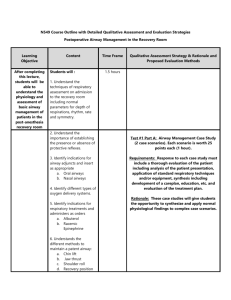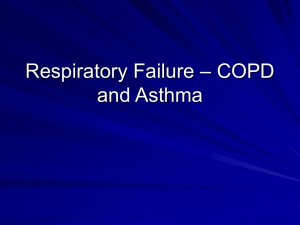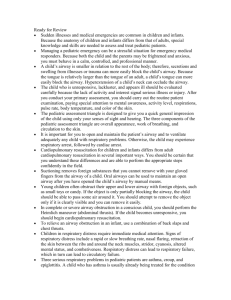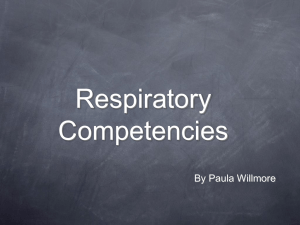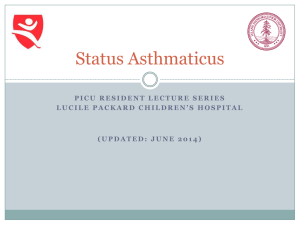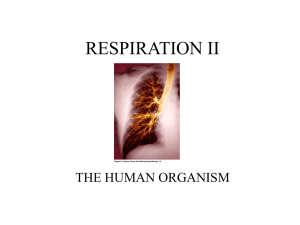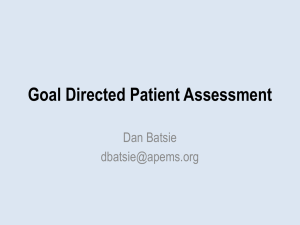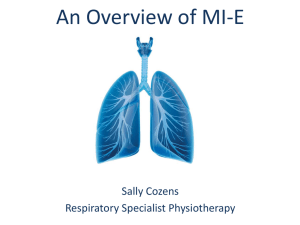2011 Asthma - Emory University Department of Pediatrics
advertisement
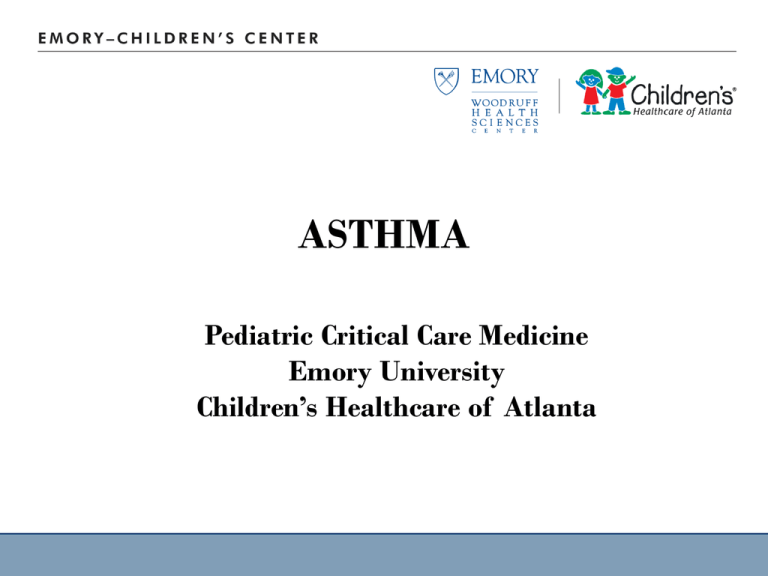
ASTHMA Pediatric Critical Care Medicine Emory University Children’s Healthcare of Atlanta Asthma • Episodes of increased breathlessness, cough, wheezing, chest tightness. • Exacerbations may be abrupt or progressive • Always related to decreases in expiratory (also in inspiratory in severe cases) airflows • Hallmarks: airway inflammation, smooth muscle constriction and mucous plugs Epidemiology Most common chronic disease in the world: varies between regions More prevalent in westernized countries but more severe in developing countries Yr of cost 2005 >$11.5 billion per year 35/100.000 fatality, mostly pre-hospital & older pop Seasonal exacerbation pattern but ICU admission remains constant <10% life threatening exacerbation: 2-20% with ICU admission; 4% intubation Reduction in mortality (63%) in the 1980’s due to inhaled steroids Asthma Prevalence 4 Pathophysiology • Airway inflammation, smooth muscle constriction, and airway obstruction • VQ mismatch (<0.1)- decrease vent with normal perfusion • Intrapulmonary shunt is prevented due to collateral ventilation, hypoxic pulmonary vasoconstriction, rarely functionally complete obstruction mild hypoxemia • Worsening of hypercapnea is indicative of impending respiratory failure in combination of lactic acidosis • Worsening of hypoxemia after beta-agonist is common due to removal of hypoxic induced pulmonary vasoconstriction Asthma Histamine Tryptase PGD2 LTC4 IL-4 IL-5 IL-6 TNF-α IL-3 IL-4 IL-5 GM-CSF Eosinophilic cationic proteins Major basic proteins Platelet activating factor LTC4, LTD4, LTE4 Pathophysiology • Lactic acidosis: – – – – – Changes in glycolysis due to high dose beta agosist; Increased wob, anaerobic metabolism Coexisting profound tissue hypoxia Over production of lactic acid by the lungs Decrease lactate clearance due to hypoperfusion Pathophysiology • Significantly reduced: FEV1; FEV1/FVC, Peak expiratory flow; maximal expiratory flow at 75%, 50% and 25%, and maximal exiratory flow between 25% and 75% of the FVC • Abnormally high airway resistance: 5-15x normal due to shortening of airway smooth muscle, airway edema and inflammation, excessive luminal secretions. Pathophysiology • Dynamic hyperinflation: Auto PEEP (intrinsic positive end expiratory pressuse PEEPi): directly proportional to minute ventilation and the degree of obstruction – Shifts tidal breathing to the less compliant part of the respiratory system pressure volume curve – Flatten diaphragm reduces the generation of force – Increase dead space increase minute ventilation for adequate ventilation – “Silent chest”: lower inspiratory flow due to dynamic hyperinflation – Asthma increases all three components of respiratory system load: resistance, elastance and minute volume – Diaphragmatic blood flow is reduced worsening of respiratory distress Pathophysiology • CV effects: “pulsus paradoxus” – decrease arterial systolic pressure in inspiration) >12mmHg – Expiration: increase in venous return, rapid RV filling shifting of interventricular septum causing LV diastolic dysfunction – Large negative intrathoracic pressure: increase LV afterload by impairing systolic emptying. – Pulmonary pressure increases due to hyperinflation increase RV afterload Clinical Presentation • Respiratory distress: sitting upright, dyspneic & communicate using short phrases • Severe obstruction: rapid, shallow breathing and use of accessory muscles • Life threatening: cyanosis, gasping, exhaustion, hypotension and decreased consciousness • PE: inspiratory & expiratory wheezes silent chest • Intensity of wheezing is not a predictor of respiratory failure • Mild hypoxemia • Blood gas: hypoxemia, hypocapnea & respiratory alkalosis in mild asthma • Normocapnea & hypercapnea: impending respiratory failure Clinical Presentation • Baseline PEF and FEV1 are important • PEF 35-50% of predicted value: acute asthmatic exacerbation • Pre-treatment FEV1 or PEF <25% or post treatment <40% predicted: indication for hospitalization Treatment • • • • • • • • • Oxygen β-agonists Corticosteroids Magnesium sulfate Anticholinergics Methylxanthines Leukotriene modulators Heliox Mechanical ventilatory support Treatment • Oxygen: supplement to keep sat>90% – Severe hypoxemia is uncommon – Careful with 100% oxygen supplementation: may result in respiratory depression followed by carbon dioxide retention Treatment • β-agonists: albuterol, terbutaline; levalbuterol, epinephrine, terbutaline – – – – – Mediate respiratory smooth ms relaxation Decrease vascular permeability Increase mucocilliary clearance Inhibit release of mast cell mediator Onset is rapid, repetitive or continuous administration produces incremental bronchodilation – MDIs: with spacer device have similar effects to nebulizer – Aerolized: » Utilize adequate flow rate (10-12L/min): higher flow rate, smaller particles (0.8-3 μm are deposited in the small airway, smaller particles tend to be exhaled) » Continuous: more consistent delivery and allow deeper tissue penetration Treatment • β-agonists : » 1- Salbutamol (albuterol): racemic mixture equal R & S isomers • S-form has longer half life and pulm retention; pro-inflammatory properties • More accumulative SE » 2- Levosalbutamol (levalbuterol): R-salbutamol • Can be beneficial after S-form accumulate with SE • Can evoke 4x bronchodilation effects with 2x systemic SE » Genetic variations in β2-adrenergic receptors: may respond favourably to neb. epinephrine Treatment • β-agonists : – 3- Epinephrine: » Alpha 1 adrenergic receptor: microvascular constriction decrease edema » Decreases parasympathetic tone bronchodilator » Improves PaO2 » SQ epinephrine » SQ terbutaline: loose β2 effect, can cause decrease uterine blood flow and congenital malformations in pregnant patients • Side effects – – – – CV: MI especially in IV isoprenaline (isoproterenol) Hypokalemia Tremor Worsening of ventilation/perfusion mismatch Treatment • Corticosteroids: – Decrease inflammation – Increase the number and sensitivity of Beta-adrenergic receptors – Inhibit the migration and function of inflammatory cells (esp. eosinophils) – No inherent bronchodilator – Administer within 1 hr of onset: lower hospitalization rate, improve pulm functions » Onset of action: 2-6 hrs » Dose 40mg/day, limited evidence of additional efficacy of 60-80mg/day – SE: hyperglycemia, hypokalemia, mood alteration, hypertension, metabolic alkalosis, peripheral edema Treatment • Magnesium sulfate: direct smooth ms relaxation and antiinflammation – Controversies in inhaled mag. sulfate – 40mg/kg/dose Q6, max 2gm in adults • Anticholinergics: ipratropium bromide – selective for muscarinic airway (proximal airway), absence of systemic effects – Slow onset of action: 60-90 min, less bronchodilation Treatment • Methylxanthines: theophyline and aminophyline – Mechanism of actions: phosphodiesterase inhibitor; stimulate endogenous catecholamine release; beta adrenergic receptor agonist and diuretic, augment diaphragmatic contractility; increase binding of cyclic adenosine monophosphate ; prostaglandins antagonist – No additional benefit in acute attack Treatment • Leukotriene modulators: – Potent lipid mediators derived from arachidonic acid with the 5lipoxygenase pathway – 2 main groups: LTB4 and cysteinyl leukotrienes (CysLTs): LTC4, LTD4, LTE4 – Mediators in allergic airway disease – CysLTs: produce: bronchoconstriction, mucous hypersecretion, inflammatory cell recruitment, increased vascular permability, proliferation of airway smooth ms – Less potent in bronchodilation and anti-inflammatory than long acting beta agonist and steroids – Administration of single IV dose or PO doses showed improvement in acute attacks Treatment • Heliox: 60-80% blend – Laminar flow, increase ventilation, decrease wob, pulsus paradoxus and A-a gradient, delay onset of respiratory muscle fatigue – Controversies in benefits – In mechanical ventilated patients, heliox helps to lower peak inspiratory pressure, improve pH and PCO2 (Shamel et al. Helium-oxygen therapy for pediatric acute sever asthma requiring mechanical ventilation. Pediatr Crit Care Med 2003:(4)) Treatment • Non invasive positive pressure ventilation – Decrease wob and auto-peep – Improve comfort, decrease need for sedation, decrease VAP and LOS – No benefits of positive pressure in delivering nebulized meds (Caroll, C. Noninvasive ventilation for the treatment o facute lower respiratory tract disease in children. Clin Ped Emerg Med) – Risks: aspiration, gastric distension, barotrauma – NIPPV + conventional managements associated with improved lung function and faster alleviation of the symptoms (Soroksy, A. et al. A pilot prospective, randomized, placebo-controlled trial of bilevel positive airway pressure in acute asthmatic attack. Chest 2003; 123:1018-25) Treatment • Mechanical ventilation – – – – Avoid excessive airway pressure, min hyperinflation Permissive hypercapnea, low TV, low rate, short I-time Continuous sedation and NMB as needed Low PEEP vs High PEEP (overcome the critical closing pressure facilitated exhalation) Treatment • Inhalational Anesthetics: Halothane, Isoflurane – Beta adrenergic receptor stimulation, increase in cAMP – ms relaxation; impede antigen-antibody mediated enzyme production and the release of histamine from leukocytes – Continuous administration: – SE: myocardial depression and arrhythmias (Vaschetto, R. et al. Inhalational Anesthetic in Acute Severe Asthma. Current Drug targets, 2009, 10, 826-32) Treatment • ECMO – When all treatment modalities failed – V-V ECMO: facilitates CO2 removal; CV stabilization; short run – Complications: brain death or CNS hemorrhage and cardiac arrest (Mikkelsen ME et al. Outcomes using extracorporeal life support for adult respiratory failure due to status asthmaticus. ASAIO J 2009; 55:47-52)
